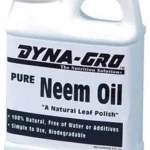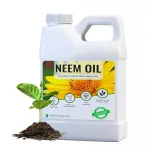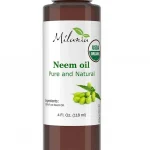Neem or Azadirachta indica has been a medicinal tree working in a medicinal dispensary for decades. Also, Neem oil greatly assists in promoting the growth of your indoor plants.
However, to keep the plants safe from leaf burn, spritz Neem oil on outdoor plants in the evening and away from direct sunlight for indoor plants.
Table of Contents Show
Is Neem Oil Safe to Use on Indoor Plants? (Neem Oil Benefits)
Neem oil, a product of the Neem Tree, serves several purposes, from its presence in soap to being used as medicine.
1. Non-Toxic
The natural ingredient of Neem oil is non-toxic, making the oil extract the best option for both plant and pet parents.
2. Organic & Biodegradable
Neem oil is also made by crushing Neem seeds and then mixing them with a solvent to be ready to use.
3. Neem Oil as Insecticide
One of the other benefits is that it protects your plants from pests in all stages of development, from eggs to fully-grown insects.
It’s most effective on aphids, mealybugs, plant scales, and similar soft-bodied insects. However, it can also kill beetles, stinkbugs, and other species.
Add all these as per the given measurement and shake well.

4. Protects Beneficial Insects
Also, its non-toxic nature helps protect beneficial insects for the growth of your plants.
Thus, beneficial insects like earthworms, ladybugs, and honeybees remain unaffected and unchanged by Neem oil.
5. Acts as Great Fungicide and Bactericide
Neem oil prevents your plant from black spots, scabs, leaf spots, tip blights, anthracnose, etcetera.
It, also known as margosa oil, is a bactericide and protects plants from bacterial wilting.
Besides, using the Neem oil helps protect your plant from Fire blight (giving it an appearance like they’ve been burnt) if it is sprayed well on twigs, branches, and stems.
6. As a Fertilizer
Neem “cake” is the best fertilizer with multiple benefits for your plant. First, this fertilizer helps your plant’s growth and protects them from insects.
The nitrogen-enriched Neem cake fertilizes the soil controlling white ants, nematodes, and other pests.
7. All Season Usage
We can use most pesticides only in a particular season or period of plant growth. However, in this case, you can use it in all the stages of plant growth all year long.
You can use it on shrubs; you can easily use it on herbs.
When to Use Neem Oil on Indoor Plants?
For a time, you can use the extract preferable to you in the case of indoor plants.
But keep in mind to take the plant away from direct sunlight while spraying so that no leaf burns occur.
As mentioned earlier, it can be used all year long and in any plant development stage. However, the best time to use this spray is during the evenings and when harvest time is not very near.
To keep your plants safe, you need to use them about 2-3 times weekly for two weeks.
Where to Use Neem Oil on Indoor Plants?
Neem oil is proven to be beneficial for indoor plants. All we need to do is take care of the appropriate mixture and fix the place where we will use it.

Confused about where to use it! Here is the detailed information.
1. In the Soil
While Neem Oil is sprayed on the soil, the root will absorb and distribute it in its vascular system.
This will provide your plants with proper nutrients. It will also make your plant infestation resistant.
Using Neem Oil as a soil soak is one of the best treatment methods.
The root absorbs the Neem Oil from the soil, becoming a systematic insecticide. Unlike topical applications, beneficial insects and bees are completely unharmed.
2. On the Leaves
Remember to apply it on both the upper and lower side of the leaf.
The lower side of the leaf is equally important because that is where the growth and development of larvae and eggs occur. Also, it is the place where pests can infest.
Apply on the entire surface and coat it well; you could form a layer.
3. On the Stems
After the leaf, spray it on the stem to prevent bacterial infections like bacterial wilting.
Neem oil can also prevent stems from fungal infections. Unfortunately, in the case of tomatoes, Neem Oil cannot stop tomato blight all on its own, but you can use it early to prevent blights.
While spraying on the herbs, only apply a small amount and remember to purge the residue before consuming it.
How do you Treat Indoor Plants with Neem Oil?
Several products of Neem can be found for these mentioned benefits. Some of them are listed below!
1. Neem Cake
Neem cake is a residue leftover while extracting essences from the seed.
It contains nutrients like; Nitrogen, Potassium, Phosphorus, Zinc, Copper, Calcium, etcetera, which are foremost for the proper growth, development, and survival of plants.
Besides, Neem Cake is an all-rounder for your plants possessing a small amount of azadirachtin oil, a natural plant antibiotic.
It is most useful in protecting the roots of plants from pests that feed on roots and fungal infections in the plant’s roots.
To use Neem cake, take a small amount and break it down on the soil.
2. Neem Oil Spray
It is a solute with an Azadirachtin composition that leaves no residue when sprayed on plants.
You can also make extract Neem Oil on your own. It’s used by adding a few spoons of Neem Oil to a gallon of water.
You may add a few drops of dishwashing detergent for better results. The best part about this is that it acts as a pesticide and makes the leaves green and shiny.
The leaves become greener because the hydrophobic composition doesn’t let Nitrogen escape.
Apply the composition away from direct sunlight always. Spray generously and soak both the upper and lower side of the leaf with this composition.
Administer it on the soil your plant is resting on and stems. Use it every 2-3 times a week for a couple of weeks.
3. Neem Oil Soil Soak
Oil Soak is another important way to keep pests away; however, it is used in its purest form here.
It is even better for indoor plants because when sprayed onto soil, it keeps the bugs under the soil away from your plant.
However, the spray doesn’t downright kill the pests but hinders their development, makes them infertile, and gradually starves them.
DIY Recipe
You will require these ingredients and follow the quick and easy Neem soil soak.
- Emulsify water to break the surface tension and allow the oil to mix.
- Add one teaspoon of dish soap to lukewarm water.
- Add 1/2 teaspoon of raw Neem Oil to your emulsified water. (1 for Quart and 2 for Gallon)
Make as much as needed since the mixture will degrade after a few days.
Alert!! Neem oil can last up to 3-22 days in the soil, while in water it can last about 50 minutes-4 days in water.
How to Use Neem Oil on Indoor Plants? [Easy Steps]
A small test on your plant is highly recommended before spraying the Neem oil on a whole plant.
1. As a Preventive Treatment
- First, mix Neem extract and water in a correct ratio, 1-2 spoons per gallon of water. Then, adding a small amount of dishwashing detergent will help better dispersal.
- Spray a thin layer on both the upper and lower parts of the leaves of your plants. Also, spray some on the stem of plants to avoid bacterial and fungal infections on your plant.
- If you are using it for the first time, try testing it on a minute part of your leaf to see if it brings out any negative reaction.
- If everything looks good, gradually spray it on all the leaves.
- You can apply the mixture before or after watering the plants. But remember to keep your plants away from direct sunlight.
- After the spray has dried off, wait 2-3 days before keeping the plant under direct sunlight.
- If you’re using an oil soak method, the practice is slightly different, as mentioned above.
- However, if your choice is a Neem cake, take a small amount, gently break it down on the soil, and spread it around.
2. As Spot on Treatment for Pests
- If the pests have already infected your plant, firstly, you’ll have to isolate the plant so that the pests will be away from the rest of the house and other plants.
- Shower the entire plant with water ( you can easily pour water down the plants).
- Now, spray your plant with the mixture you made earlier by mixing a small amount of Neem Oil and dishwashing soap detergent with emulsified water.
- Spray on all the leaves and make a thin layer. Closer attention has to be given to the plants, which are bugs infested.

3. Used to Shine the Foliage
You can also spray a small amount on the soil. Keep your treated plant away from sunlight and other plants for a few days.
Repeat the process 2-4 times, and your plant will be healthy to return to its place.
Things to Consider When Using Neem Oil
While using it on plants, there are certain things you need to remember.
- Firstly, use it on a small leaf area to check whether your plant has adverse effects. Then, spray it on the rest of the plant if everything looks good.
- Always spray just the amount required by the plant because small herbs, even other plants, cannot take in large amounts of anything, whether that be anything.
- Since the oil is nondispersive, you always have to put in a dishwashing soap detergent. Also, while using, spray it to make a thin layer on your leaves so that you leave no parts for bugs to feed on.
- It also has a strong smell, so always use it in small amounts, or it might give you a headache.
- While spraying, remember to keep your plant away from direct sunlight.
- Try not to spray on small plants because they’re fairly sensitive. If applied without proper precaution, young plants might have their leaves curled, burnt, or worse; the plant may die.
- Even after spraying, keep the plants away from sunlight for 2-3 days so your leaves don’t get sunburned.
- While spraying, do not let the spray directly enter your eyes. It may cause a burning sensation in your eyes for a long period.
Best Neem Oils of 2023
Below are the best Neem Oils in the market that you can use.
| Name of Neem Oil | Features | Picture |
|---|---|---|
| Dyna-Gro Neem Oil | It is 100% cold-pressed neem oil. Is free from silicon. Can be used as an insecticide, fungicide, and leaf gloss. |  |
| Neem Organics Pure Neem Oil | Can be used till the harvest time Its 100% neem oil Its highly concentrated |  |
| Milania Pure Organic Neem Oil | Multi-purpose neem oil Does not contain preservatives Works as an antibiotic too |  |
| Verdana USDA Organic Cold Pressed Neem Oil | Suitable for indoor use Suitable for indoor usage Doesn’t have residual effects |  |
FAQs about Neem Oil on Houseplants
1. Is it Safe to Eat Herbs Treated with Neem Oil?
You can eat the herbs treated with Neem Oil.
Neem oil is non-toxic, and they do not leave any residue.
However, while eating the herbs treated with Neem Oil, rinse them thoroughly. Also, while using Neem Oil, use only the product with pure Azadirachtin and nothing else.
2. Is Neem Oil Safe for My Plant?
Neem oil is entirely safe for indoor and outdoor plants when used incorrectly.
Neem oil is organic, so you don’t have to worry about synthetic chemicals harming your plant.
It is also bio-degradable and silicon-free so it won’t interfere with your plant’s natural processes.
3. What Houseplants do not Like Neem Oil?
Some plants, including Basil, Caraway, Dill, Marjoram, Cilantro, Oregano, Parsley, and Thyme, cannot tolerate Neem oil. The oil can cause foliage burns.
From Editorial Team
Conclusion!
This pest control might have some weaknesses, but it works like magic on plants by helping them fight against bacterial, insect, and fungal infestations.
Don’t let that utterly unsetting take over your indoor garden. Instead, research all you can, use healthy organic pesticides and nourish your plants.

2 comments
Thanks for sharing the use of neem oil in indoor plants. I really like a article.
Thank you for the comment. Please read our other articles and keep us updated on how your plants are holding up after a neem spray.